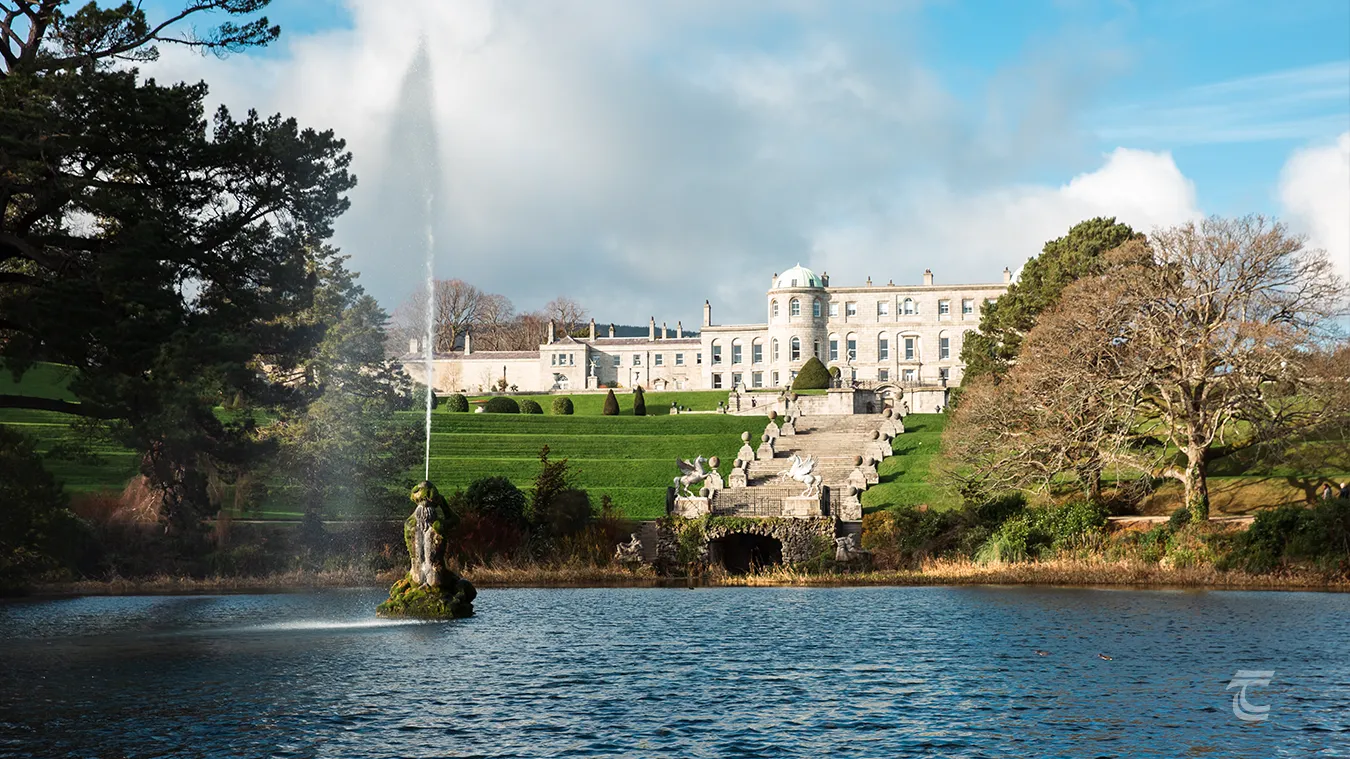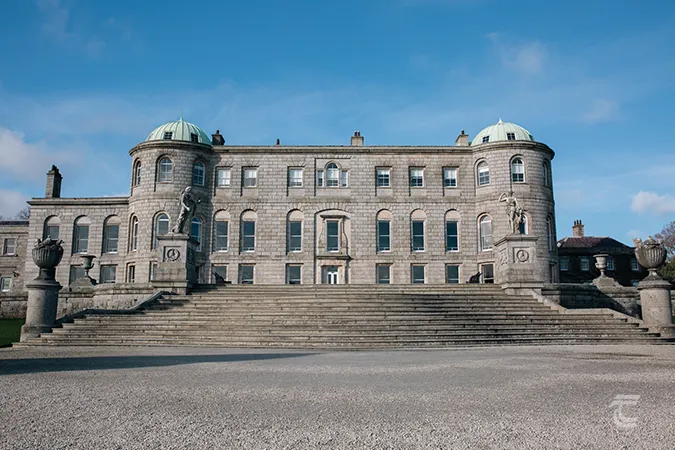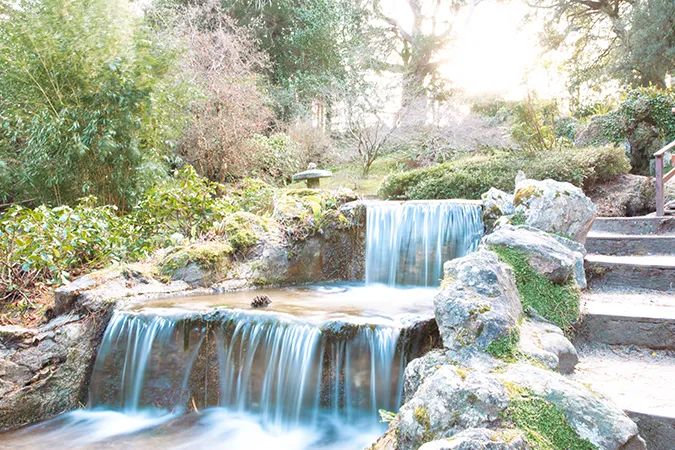Powerscourt House and Gardens
The historic gardens of Powerscourt are world renowned, once voted third best in the world by National Geographic Magazine, and the estate has a long and fascinating history. The story of Powerscourt begins with the medieval castle that once stood on the site. It was established by the Anglo-Norman de Paor family, and it is from them that Powerscourt takes its name, as ‘Paor’s Court’ which later became anglicised to Powerscourt. This castle was sited in a strategic location that commanded the nearby Dargle, Glencree and Glencullen Rivers. The control of this area was vital to the Anglo-Norman colony, as the hinterland of their burgeoning city of Dublin was regularly raided and plundered by the powerful Irish tribes who made the Wicklow Mountains their stronghold, especially the O’Byrnes and O’Tooles. The castle did not deter these Irish tribes for long, though, and by the end of the 14th century, the O’Toole family were in possession of Powerscourt. By this time, the Wicklow Mountains had become a deadly and fearful place for the English, as the Irish asserted their dominance and demanded protection money and tribute along the southern border of the Pale. After centuries of conflict between the English forces and the O’Tooles, in 1540 Turlough O’Toole was finally persuaded to make peace with the Crown in exchange for recognition of the lands he had won.
For practical information about visiting this site Click Here

Powerscourt House and Gardens • Wicklow
The O’Tooles and Powerscourt’s Early Years

Powerscourt House • Wicklow
The O’Tooles were granted extensive lands, in return they were pledged to obey the King’s law, speak English and were bound to keep Powerscourt Castle in a good state and clear ways through the forested mountains of the O’Tooles. Turlough was to encourage more farming by keeping arable lands in tillage, build houses for farmers and encourage his followers to adopt English and English dress, and not to harbour enemies of the Crown. However, just decades later, the O’Tooles were to have Powerscourt and their lands confiscated, following the disastrous Battle of Kinsale, where the O’Toole’s once again took arms against the Crown.

Powerscourt House • Wicklow
Powerscourt House

Flowing water in the elegant Japanese Garden • Powerscourt House
Powerscourt and surrounding lands were granted to Richard Wingfield, a favourite of Queen Elizabeth I. In 1618, when he was 68, Richard Wingfield became the first Viscount of Powerscourt. However, this title died with him as he left no direct heir. The estate passed instead to his cousin Edward. When Cromwell invaded Ireland in the middle of the 17th century, Powerscourt was burned and partially levelled to prevent Cromwell’s forces from using it as a base. Despite this, the Wingfields retained control of their lands throughout this turbulent time. Their fortunes were uplifted when Folliot Wingfield married Elizabeth, the eldest daughter of the wealthy Robert Boyle. Folliot went on to become Viscount Powerscourt of the Second Creation, and he and his wife Elizabeth were to rebuild parts of the castle during their 50-year marriage.
They had no children to pass the title onto so the title died once again. The estate passed to a cousin who died shortly after inheritance, which then passed onto his son, Richard Wingfield. It was this Richard who was responsible for the reconstruction of the house in the 18th century. He appointed the famous architect Richard Castle, who was noted for designing famous buildings in Dublin such as Leinster House, the redesign of Carton House and Russborough House, as well as Conolly’s Folly, built for the Conolly’s of Castletown House. The construction of the new house at Powerscourt was completed in 1741, in the stately Palladian style, with 68 rooms.
Powerscourt was passed through the Wingfield family until 1961 when it was sold to the Slazenger family, who had become wealthy through sports and leisure products. They undertook a large programme of restoration and renovation. However, their toil turned to tragedy when a large fire destroyed the house and most of its contents in 1974. The house remained roofless until 1996, when another large programme of works was carried out to help to transform Powerscourt into the fine visitor attraction it is today.
Powerscourt Gardens

Powerscourt House viewed from the Pepperpot Tower • Wicklow
The gardens of Powerscourt are stunning. There were two main phases of development in the gardens. The first began in the eighteenth century, at the same time that the house was being redesigned. The second phase of landscaping was carried out in the 19th century under the direction of architect Daniel Robertson. He was highly renowned and his work shows influence from Italianate garden design, in a number of beautiful terraces, and the striking fountain in the lake is based on the famous fountain of Piazza Barberini in Rome.
Robertson was said to be quite the character. He apparently suffered badly from gout, so he commanded the works from a wheelbarrow while clutching a bottle of sherry to fortify him. Works on Powerscourt Gardens continued throughout the 19th century, with some of the iconic features added like the Pepper Pot Tower and Japanese Gardens. Powerscourt Waterfall is a short drive from the House and Gardens, and is Ireland’s highest waterfall at 121 metres (nearly 400 feet) high. With elegant gardens and a compelling story, Powerscourt is always a lovely place to explore.

Powerscourt House viewed from the Pepperpot Tower • Wicklow
Upper left: the elegant gardens • Lower left: statuary in the gardens • Right: the Pepperpot Tower
Top: the elegant gardens • Middle: the Pepperpot Tower • Bottom: statuary in the gardens
Powerscourt Visitor Information
Powerscourt House and Gardens are renowned for their beauty and make for an enjoyable family day out.
Explore more sites in Ireland’s Ancient East


